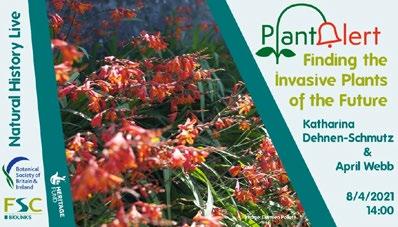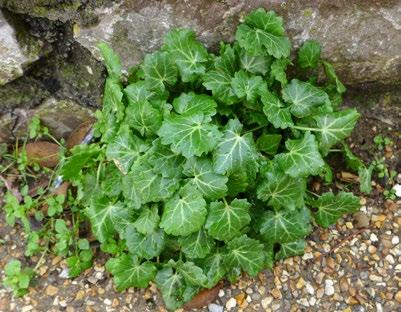
52 minute read
Compiled by Matthew Berry
ADVENTIVES AND ALIENS
Adventives and Aliens News 26
Advertisement
Compiled by Matthew Berry
Flat 2, Lascelles Mansions, 8–10 Lascelles Terrace, Eastbourne BN21 4BJ
m.berry15100@btinternet.com
Two records of Silene dichotoma (Forked Catchfly) brought to my attention in 2021 clearly result from the inclusion of its seeds in so-called wild flower mixes, one on a suburban roadside and the other in an arable field margin, see v.cc.11 and 12 respectively. This is a means of introduction quite distinct from that implicated in v.c.10 recently, where it had been found growing presumably as an impurity amongst a clover crop. What exactly this will mean for future records of the species remains to be seen but it is certainly an interesting development. In 2021, Brighton-based botanist Tony Spiers reported having found Salvia hispanica (Chia) in five tetrads of his home town (TQ30C, G, H, J and P) with the typical habitat being wall bases. Some of the plants came very close to flowering, unlike those I have seen in Eastbourne. He also made reference to a 2018 article on the Hodmedod’s British Wholefoods website, in which it was revealed that two farmers from Great Tey in Essex had successfully grown the first ever crop of British Chia, a species previously not thought to grow to maturity in the British climate. This feat involved the selection of a suitable strain capable of yielding seeds in our growing conditions. Does this help to explain the recent mini explosion of records (15 in the DDb, 2013–2021), or does it predict the appearance of even more plants of flowering Chia in our streets?
V.c.6 (N. Somerset)
Eucalyptus gunnii (Cider Gum). Weston-super-Mare (ST31466193), 30/10/2021, Somerset Rare Plant Group (comm. H.J. Crouch): one sapling on west side of Greenfield Place, self-sown from trees nearby. New to v.c.6. An evergreen tree (Myrtaceae) native to temperate, mountainous areas of Tasmania. A fastgrowing species with a graceful, open mature growth form up to 30m, the adult leaves are lanceolate with a blue-grey bloom (the juvenile leaves more or less orbicular) and apparently virtually odourless when crushed. As it does well in most parts of the country and on most soil types, it has become particularly popular as an ornamental species. The woody, urnlike capsules occur in threes and contain many small seeds. Even so it only seems to self-sow rarely outside gardens. Stace (2019): 391.
Eryngium variifolium (Moroccan Eryngo). Weston-super-Mare (ST31246181, ST31256183), 30/10/2021, SRPG (comm. H.J. Crouch): one vegetative plant in paving and one fruiting plant beneath a boat against a low sea wall. The parent was in a flower bed nearby. New to v.c.6 and Somerset. A garden plant (Apiaceae) native to Morocco, also planted in municipal beds, etc. and self-sowing from them quite readily. It was recorded in a similar situation for the first time in Eastbourne, v.c.14, in 2020 (M. Berry), and a few years before
Eryngium variifolium, Weston-super-Mare, North Somerset (v.c. 6). Helena Crouch
in Hastings (J. Rose); neither record in the DDb. See BSBI News 122, pp. 39–40. Stace (2019): 850.
Miscanthus × giganteus (Giant Silver-grass). Cheddar Head (ST51095199), 24/6/2021, E.J. McDonnell (comm. H.J. Crouch): one huge clump in rough grassland near scrub. A presumed escape rather than relic of cultivation, a very rare event apparently as widely planted in the area. New to v.c.6 and Somerset. A rhizomatous perennial hybrid grass originating in Japan, planted in gardens and municipal beds, etc., it differs from M. sinensis (Chinese Silver-grass), one of the parents, in being more robust and in having unawned lemmas. It is increasingly grown as a biomass crop. Stace (2019): 1112.
V.c.9 (Dorset)
Akebia quinata (Houtt.) Decne. (Chocolate Vine). Near Swanage (SZ00528080), 29/10/2021, D. Leadbetter: clambering over vegetation on east side of lane, north of Knitson Old Farmhouse. A deciduous woody climber (Lardizabalaceae) with palmate leaves usually of five, glabrous, oblongobovate leaflets and racemes of reddish-brown flowers, the larger female flowers being positioned at the base. The flowers consist of three or four petaloid sepals and have a chocolatey aroma, thus accounting for the English name. It is a native of east Asia and an invasive introduction in the US. It will most probably be found as a reject of cultivation or
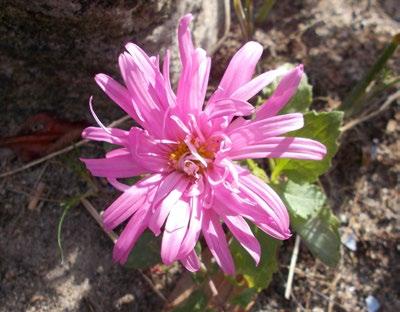
Callistephus chinensis, Swanage, Dorset (v.c. 9). David Leadbetter ramping out of gardens, although the large, sausageshaped fruits, up to 10cm in length, do apparently sometimes develop in this country.
Callistephus chinensis (China Aster). Swanage (SZ03068044), 19/10/2021, D. Leadbetter: one on pavement, Bay Close. An erect, branched annual garden plant (Asteraceae), native to China. The large, showy, radiate capitula (one per branch) and an involucre of very leafy, outer phyllaries (the inner ones are chaffy) make this plant quite distinctive. It was formerly in the genus Aster. Stace (2019): 786.
V.c.11 (S. Hants)
Silene dichotoma (Forked Catchfly). Milford (SZ27349239), 7/9/2021, M. Rowe (det. E.J. Clement): sown with other ‘wild’ flowers on a road side, West Road (Studland Common area). Stace (2019): 503. See Adventives & Aliens News 23, v.c.10 and v.c.12 below.
Artemisia scoparia Waldst. & Kit. (Redstem Wormwood). Lymington (SZ32809546), 12/10/2021, M. Rowe (det. E.J. Clement): one erect bushy plant in road side gutter, Nelson Place. It resembles A. annua (Annual Mugwort) in being (usually) glabrous and having a diffuse, paniculate inflorescence, but it is scarcely aromatic and all of its leaf segments are filiform. A Eurasian native (Asteraceae), it was a wool alien but the vector in this case can only be guessed at.
V.c.12 (N. Hants)
Vicia villosa (Fodder Vetch). Aldershot (SU85855078), 16/8/2021, F. Rumsey: on bank by the underpass to Tesco. This is almost exactly where Tony Mundell recorded V. villosa in 1990, although the area was then a large, botanically rich area of sandy waste ground that has since been developed. Stace (2019): 169.
Acer pensylvanicum L. (Moosewood). Hurstbourne Tarrant (SU39165628), 20/10/2021, P. Billinghurst (det. C. Crook): on verge of minor road through Faccombe Wood. New to Hampshire and only the eleventh record for Britain. A small deciduous tree (Sapindaceae) native to N. America, which has broad,

Vicia villosa, Aldershot, North Hampshire (v.c. 12). Fred Rumsey soft leaves each with three obvious, caudate lobes. It can be distinguished from A. cappadocicum and A. monspessulanum by the serrate leaf lobe margins, from A. rufinerve by the absence from the young shoots of a whitish bloom, and from A. tataricum by the bivalvate bud scales, invariably three-lobed leaves and distinctly striped bark.
Cardamine raphanifolia (Greater Cuckooflower). Fleet Pond (SU81855471), 4/5/2021, A. Mundell: a few patches on stream bank, Brookly Stream. It has increased since first recorded here by Tony Mundell in 2015. A relatively robust, rhizomatous, more or less unbranched perennial crucifer with purplish-red petals, glabrous stems rooting at the lower nodes and Barbarea-like basal and stem leaves. A southern European native grown occasionally in gardens. The bulk of records are scattered in more northern and western v.cc. and it is almost absent, as an escape, from south-east England. Clement et al.(2005): 105. Stace (2019): 425. See v.c.64.
Silene dichotoma (Forked Catchfly). Crawley (SU432347), 30/6/2021, T. Norton: frequent in sown pollinator/bird-seed margin.
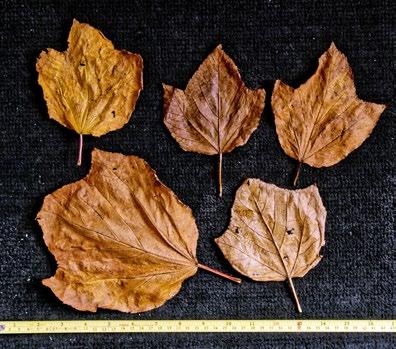
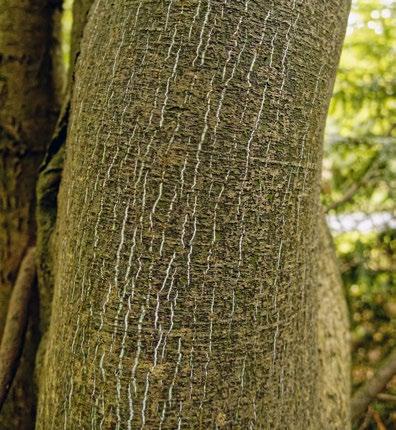
Acer pensylvanicum, Hurstbourne Tarrant, North Hampshire (v.c. 12). Peter Billinghurst
V.c.13 (W. Sussex)
Ballota acetabulosa (False Dittany). Bognor Regis (SZ93449884), 2021, D.M. Donovan: three plants on shingle close to entrance of Pier; Littlehampton (TQ00F), 2021, D.M. Donovan: one smaller overwintering plant, Pier Road. It is much planted by Arun District Council on the most exposed parts of the coast in Littlehampton and Bognor Regis (pers. comm.). David Donovan thinks that the plants probably derived from shoots that have broken off and rooted. A perennial garden plant (Lamiaceae),
native to south-eastern Europe. Adventives & Aliens News 12, v.c.5. Stace (2019): 657.
Crocus speciosus (Bieberstein’s Crocus). Widewater (TQ20100417), 27/8/2021, Sussex Botanical Recording Society (det. S. Denness/conf. M. Berry): three small groups, probably planted originally. Stace (2019): 934.
V.c.14 (E. Sussex)
Convolvulus cneorum L. (Shrubby Bindweed). Lewes (TQ4010), 7/2021, P. Harmes: self-sown plant by path, Fitzjohns Road. The first Sussex record. Adventives & Aliens News 13, v.c.9.
Cymbalaria pallida (Italian Toadflax). Cooden Beach (TQ71050664), 26/10/2021, J. Clark, J. Rose & E. Campbell: one plant on strip of ground between base of wall and pavement, apparently escaped from nearby garden. A new tetrad record and only the third site for Sussex. This species has been known in TQ70I/N since at least 1988. A shortly hairy, decumbent, patch-forming perennial (Veronicaceae, formerly in Scrophulariaceae) native to Italy. It is far less frequently grown than C. muralis (Ivy-leaved Toadflax) and as an escape is seen far less often in south-east England. Clement et al. (2005): 246. Stace (2019): 628.
Mentha × villosonervata (Sharp-toothed Mint). Eastbourne (TQ62800175), 20/7/2020, M. Berry (conf. R.M. Harley): a large patch in long grass by cycle path, St. Anthony’s Hill, Langney, where it is likely a garden throw-out. It is probably the first confirmed Sussex record. This sterile triploid hybrid (Lamiaceae) could be overlooked for hairy forms of M. spicata (Spearmint). Stace (2019): 673.
V.c.27 (E. Norfolk)
Geranium palmatum Cav. (Canary Island Cranesbill). Holt (TG08103859), 25/2/2021, T. Doncaster & S. Pryce: seeding along a road side hedge. A garden plant (Geraniaceae) found as a native species in Madeira. The first Norfolk record. One gardener who has had a chance to compare G. palmatum and the rather similar G. maderense (Giant Herb-Robert) (also a Madeiran native) growing side by side, observed that the former is a longer lived perennial,
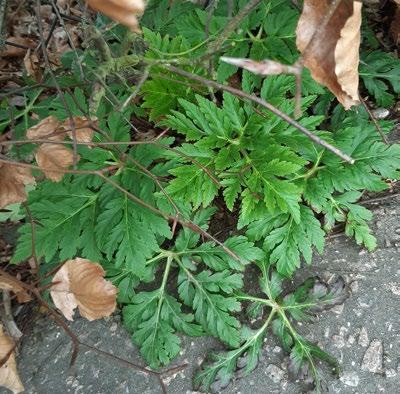
Geranium palmatum, Holt, East Norfolk (v.c. 27). Suki Pryce
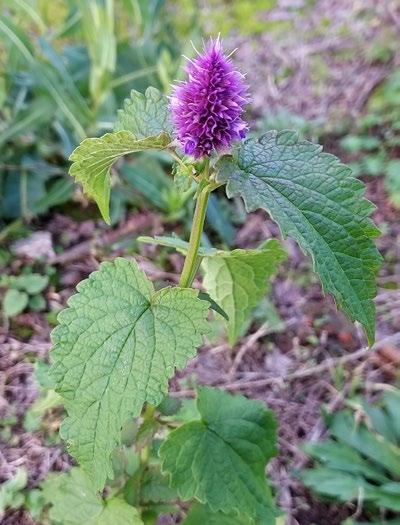
Agastache rugosa, Sheringham, East Norfolk (v.c. 27). Mick Lacey
somewhat more hardy, with smaller, fresher applegreen leaves which lack the reddish tinge seen in the latter. In the DDb there are also records for
v.cc.1 (1978), 5 (2012, 2021), 21 (2011), 33 (2019), 83 (2016, 2017 and 2019) and H6 (2006).
Agastache rugosa (Fischer & Meyer) Kuntze (Korean Mint). Sheringham (TG14694307), 12/10/2021, M. Lacey (comm. M. Lacey): one flowering and several non-flowering seedlings in gravel path bisecting allotments, with Erigeron sumatrensis (Guernsey Fleabane) and E. floribundus (Bilbao’s Fleabane). It did not seem to be in cultivation anywhere nearby (Mick Lacey pers. comm.). See Adventives & Aliens News 3, v.c.H39 and v.c.47 below.
V.c.28 (W. Norfolk)
Erodium manescavii (Garden Stork’s-bill), Swaffham (TF81970795), 16/10/2021, Norfolk Flora Group: a single plant on a mown suburban verge c.2m from garden boundary, growing with local E. moschatum (Musk Stork’s-bill), a robust version of which it was seen to somewhat resemble. The first Norfolk record. A stemless, perennial garden plant (Geraniaceae) native to the Pyrenees with bracts fused in a cupule and glandless apical mericarp-pits. The magentapurple flowers are c.3cm across. Stace (2019): 375.
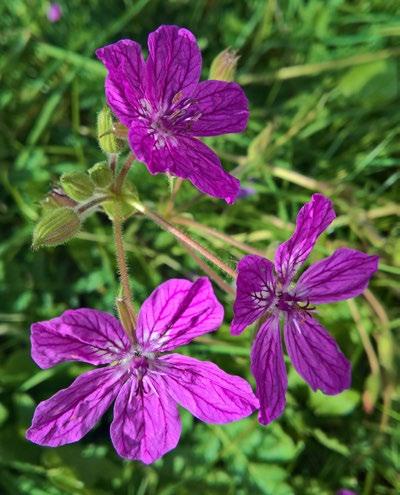
Erodium manescavii, Swaffham, West Norfolk (v.c. 28). Jo Parmenter
Clerodendrum bungei Steud. (Glory Flower). Kenninghall (TM03498638), 9/10/2021, Norfolk Flora Group: a population spread over c.10m of rural road verge outside a garden. The first Norfolk record. The status is somewhat uncertain and an initial deliberate introduction cannot be categorically excluded. See Adventives & Aliens News 18, v.c.17 and Adventives & Aliens News 22, v.c.9.
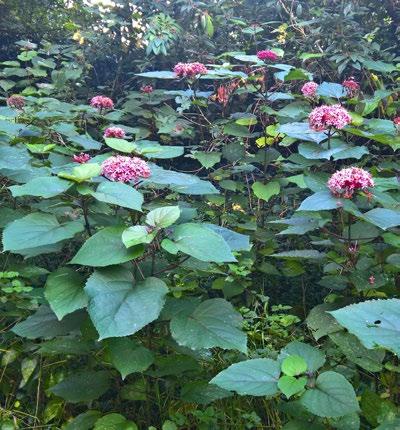
Clerodendrum bungei, Kenninghall, West Norfolk (v.c. 28). Jo Parmenter
V.c.35 (Mons)
Laphangium luteoalbum (Jersey Cudweed). Garndiffaith (SO26600472), 8/8/2021, L. Gregory (comm. S. Tyler): growing in a plant pot with a large dying conifer at a school. The first v.c. record. It has also recently colonised pavements in Cardiff Bay in East Glamorgan.
V.c.38 (Warks)
Marsilea hirsuta R. Br. (Bristly Water-Clover). Baddesley Ensor (SP27299838), 29/10/2015, J. & M. Walton (conf. F. Rumsey & H. Schaefer, 11/10/2021): introduced in a newly dug wildlife pond on Baddesley Common. It was tentatively identified as M. quadrifolia L. (Clover Fern), a native of the Mediterranean region found in seasonal pools. It was not until 2021, after Fred Rumsey
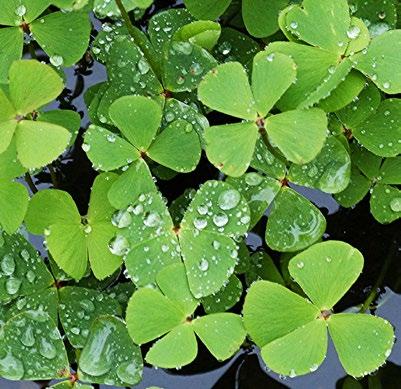
Marsilea hirsuta, Baddesley Ensor, Warwickshire (v.c. 38). John Roberts
had sent material to Hanno Schaefer in Munich that the plant’s identity was settled definitively using molecular methods. M. hirsuta (Marsileaceae) is a native of Australia and an invasive alien in N. America and in the Azores where they had called it M. azorica Launert & Paiva. John Walton comments that M. hirsuta is widely available to buy for aquarium and terrarium use. The fern has survived in this site for seven years and this is quite possibly the first record of it for Britain and Ireland. Pilularia globulifera (Pillwort) is, of course, a native representative of the family in this country.
V.c.47 (Monts)
Agastache rugosa (Fischer & Meyer) Kuntze (Korean Mint). Machynlleth (SH74620080), 28/10/2021, D. Elias (det. M. Berry): one plant growing in a crack between a south-facing wall and the pavement in high street. There are no other records for v.c.47 in DDb.
V.c.50 (Denbs)
Anchusa azurea (Garden Anchusa). Pensarn (SH92917822), 25/5/2021, T. Cumberlidge (det. D. Williams): established on beach, Hen Wrych Farm; Pentre Mawr Park (SH94167855), 16/6/2021, D. Williams & M.O. Stead: single large plant in flower on right-hand side of gate below and just west of road bridge (more plants were found at this site later in the season). The first and second v.c. records respectively. It later emerged it has been present at the Hen Wrych site for years (Delyth Williams pers. comm.). An erect, thick-stemmed, much branched perennial garden plant (Boraginaceae) that has hispid leaves up to 30cm long (the lower stalked, the upper not), bracteate cymes of rich blue flowers (the limbs c.10–20mm across, the corolla lobes about as long as the tube and the throat obscured by tufts of white hairs) and calyces divided almost to the base into lanceolate lobes. The mature nutlets are 6–10mm long. A native of Eurasia and N. Africa where its habitats include fields, vineyards and waysides. As well as escaping from gardens it has also been recorded as a grain and bird-seed casual. ‘An established fodder alien naturalised since 1914–18 war on dunes at Upton Towans (v.c.1)’, Clement & Foster (1994). The last record of it in this area in DDb, for 2013. Stace (2019): 592.
V.c.57 (Derbys)
Chenopodium striatiforme Murr (a Goosefoot). Gladwin’s Mark (SK30526680), 15/8/2021, M. Lacey (conf. J. Akeroyd): a weed in a field of fodder beet, Beeley Lane. Mick Lacey commented that the most distinctive feature of the plant was its diminutive size (30–60cm tall, leaves 3–6cm wide). C. strictum/C. striatiforme are probably best distinguished from C. album (Fat-hen) and C. suecicum (Swedish Goosefoot) by differences in leaf shape. C. strictum (Striped Goosefoot) is a much larger plant than C. striatiforme with red-striped stems. C. striatiforme is not recognised as being distinct from C. strictum in Stace (2019), however it is treated as a separate species in Sell & Murrell (2018).
V.c.63 (S.W. Yorks)
Erysimum × marshallii (Siberian Wallflower). Woodlesford (SE36452935), 6/6/2021, D.A. Broughton: on footbridge over railway. It has persisted here for several years. As well as occasional seedlings it can be seen on tips and where there has been garden dumping. A biennial garden hybrid
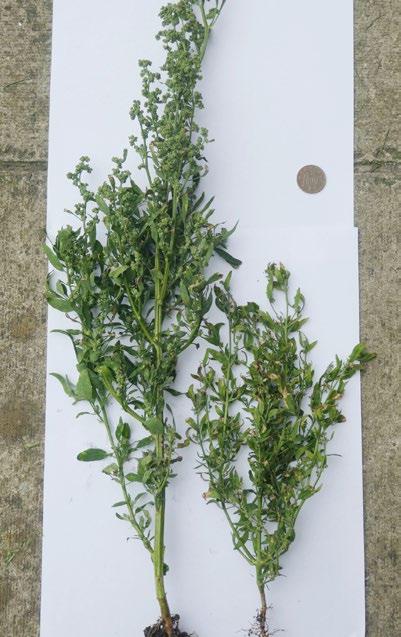
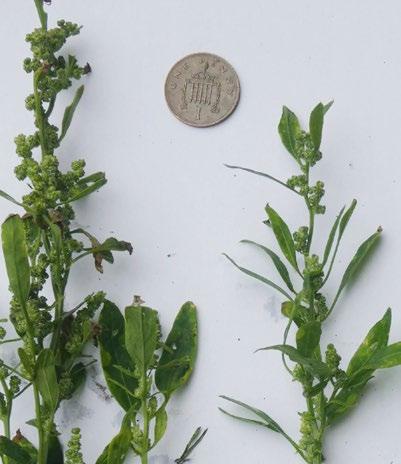
Chenopodium striatiforme, Gladwin’s Mark, Derbyshire (v.c. 57). Mick Lacey (Brassicaceae) with uniformly orange, sweetly scented flowers. Stace (2019): 417.
Chenopodium opulifolium (Grey Goosefoot). Rothwell (SE34532666), 22/8/2021, D.A. Broughton: locally frequent by muck heaps for the stables, Swithen’s Farm. A Eurasian, N. African native found on tips and waste ground with various vectors implicated, including grain, bird-seed and wool. It superficially resembles an unusually mealy C. album (Fat-hen) and has rather distinctive leaves – the blades are relatively short, almost as wide as long, often threelobed, roughly rhombic in outline, few-toothed or entire and densely mealy or glaucous on both sides. Stace (2019): 517.
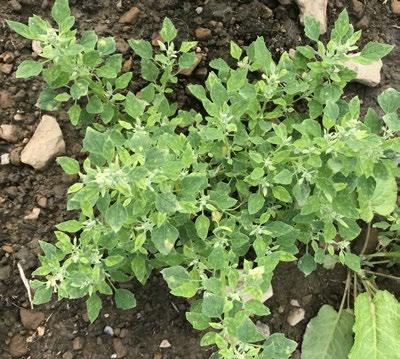
Chenopodium opulifolium, Rothwell, S.W. Yorkshire (v.c. 63). David Broughton
V.c.64 (M.W. Yorks)
Cardamine raphanifolia (Greater Cuckooflower). Dangerous Corner (SE20305578), 19/6/2021, M.P. Wilcox (comm. D.A. Broughton): on mounds near entrance to Long Stoop Farm.
Bromopsis inermis subsp. inermis (Hungarian Brome). Aberford (SE43004000), 21/7/2021, M.P. Wilcox: near A1, Junction 44. A rhizomatous spreading perennial grass with culms up to 1.5m, widespread as a native in Europe and Asia (subsp. inermis). It has been grown as a fodder crop and to provide food for pheasants, as well as being a wool alien and an (accidental?) introduction with grass
Erysimum × marshallii, Woodlesford, S.W. Yorkshire (v.c. 63). David Broughton seed. The origin of any given occurrence is not always obvious, however. Clement et al.(2005): 398. Stace (2019): 1094. See v.c.79.
also found in quantity in a cleared greenhouse site at the other end of the island on the Route Militaire by the botany section of La Société Guernesiaise. These are the first Guernsey records, although it is already known in Jersey. Stace (2019): 359. Asparagus densiflorus (Kunth) Jessop Sprengeri Group (Plume Asparagus). Guernsey, 9/2021, J. Grange (det. E.J. Clement/comm. H. Litchfield): on a hedge bank below a reclamation reserve, as a relic of cultivation for the floristry trade, with Tradescantia fluminensis (Wandering-jew) and Sedum cf. kimnachii (Kimnach Stonecrop), Ruette de la Hougue, Castel. The first v.c.113 record. A S. African native (Asparagaceae) which because of its cascading habit and needle-like foliage has decorative value as an indoor potted plant and in cut flower arrangements. In Clement & Foster (1994), where it is listed as Asparagus aethiopicus L., it is described as being ‘a casual greenhouse escape’.
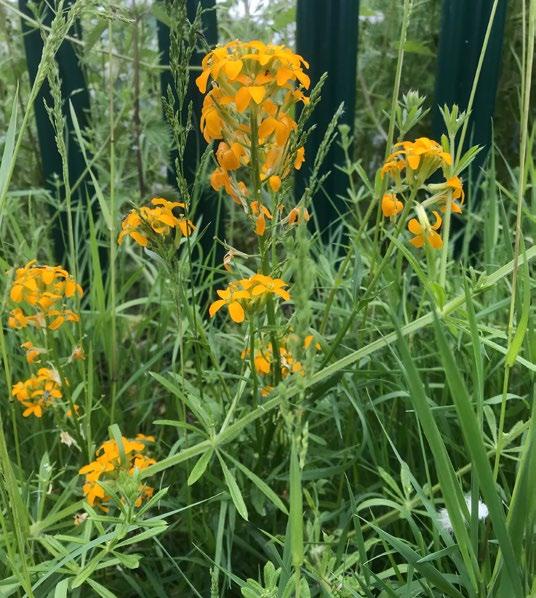
References
V.c.79 (Selkirks)
Bromopsis inermis (Hungarian Brome). Galashiels (NT47483735), 5/6/2020, L. Gaskell (conf. A. Copping): patch spreading by rhizomes, wooded bank near Gala Water, next to A72. Luke Gaskell observed that the spikelets contained no viable seed when checked in the autumn. The lemmas were short-awned (they can be completely unawned) and the leaf sheaths were glabrous, indicating subsp. inermis. Its origin is unknown.
V.c.113 (Channel Islands)
Clement, E.J. & Foster, M.C. 1994. Alien Plants of the British
Isles. Botanical Society of the British Isles, London. Clement, E.J., Smith, D.P.J. & Thirlwell, I.R. 2005. Illustrations of Alien Plants of the British Isles. Botanical Society of the
British Isles, London. Poland, J. & Clement, E.J. 2020. The Vegetative Key to the British
Flora (2nd edn). John Poland, Southampton. Ryves, T.B., Clement, E.J. & Foster, M.C. 1996. Alien grasses of the British Isles. Botanical Society of the British Isles,
London. Sell, P.D. & Murrell, G. 2018. Flora of Great Britain and Ireland,
Vol. 1. Cambridge University Press, Cambridge. Stace, C.A. 2019. New Flora of the British Isles (4th edn).
C & M Floristics, Middlewood Green, Suffolk.
Euphorbia maculata (Spotted Spurge). Guernsey, 8/2021, J. Grange (comm. H. Litchfield): one plant in a gateway in the Rue des Goddards, Castel. It was
Centranthus ruber: Spread of a non-native in the British Isles, with a focus on v.c. 57 (Derbyshire)
DAVID P. BLOWERS
Centranthus ruber (Red Valerian) is a naturalised neophyte that has its origins in the Mediterranean region and, in the British Isles, is commonly found on walls, dry rocky, shingly or sandy places, cliffs and banks (Stace, 2019). Its red,
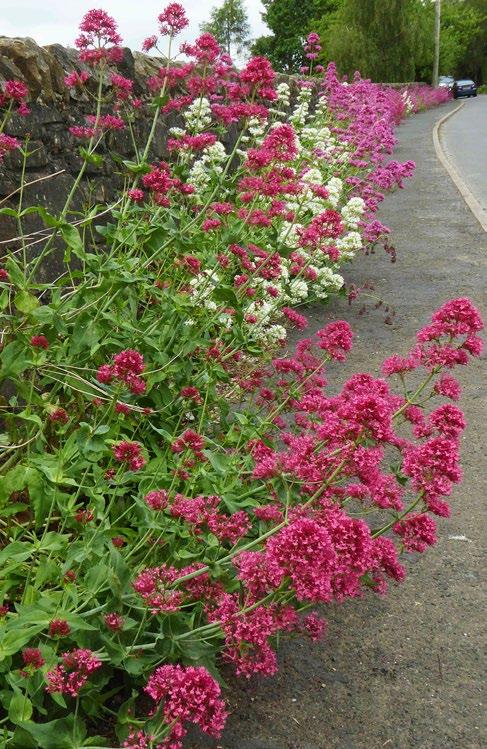
Centranthus ruber (Red Valerian) on a roadside in SK08, Derbyshire (v.c. 57), June 2021. Angela Caunce pink or white flowers add a touch of colour to many places from June to August (Rose & O’Reilly, 2006).
Casual observations in and around my ‘home’ hectad, SK08 within v.c.57 (Derbyshire), seemed to give the impression that C. ruber was increasing in abundance. Encouraged by the drive to explore the records within the BSBI Distribution Database (DDb) (Walker, 2021), an analysis of the distribution and temporal spread of C. ruber was undertaken. In addition, a more detailed analysis was performed for v.c.57.
The DDb was interrogated for all records containing C. ruber. Those records with a year entry (‘year from’ field) were then divided by region. Table 1 shows the earliest such records for C. ruber in regions of the British Isles. The earliest such record is for v.c.2 in 1758 (near Truro in Cornwall) where it was probably introduced as a garden ornamental.
The downloaded records reveal the increase in vice-counties (v.cc.) containing C. ruber. Figure 1 summarises these data in terms of the number of v.cc. (Figure 1a) and the percentage of v.cc. within a region (Figure 1b). For England, Scotland & Wales the upward trend in records begins around the 1950s, followed by Northern Ireland and Eire in the early 1990s. Having just a single v.c., the Channel Islands is represented from 1900 onwards with no trend as such. Within these data it is also interesting to note a spike in v.cc. for 1950 (reason unknown) and the drop in v.cc. towards the end of the time
Table 1. Earliest records for C. ruber in the DDb. Area Earliest year Vice-county England 1758 2 (E. Cornwall) Scotland 1840 85 (Fife) N. Ireland & Eire 1866 H12 (Co. Wexford) Wales 1877 47 (Monts.) Isle of Man 1880 71 Channel Islands 1900 113
100
90
counties Number of Vice -
80
70
60
50
40
30
20
(a)
10
0
1750 England, Scotland & Wales N. Ireland & Eire Channel Islands
1777 1804 1831 1858 1886 1913
Year recorded
1940 1967 1994 2021
100
counties % of Total Vice -
90
80
70
60
50
40
30
20
10
(b)
England, Scotland & Wales N. Ireland & Eire Channel Islands
0
1750 1777 1804 1831 1858 1886
1913 Year recorded
1940 1967 1994 2021
Figure 1. Monad and Year specific records from the DDb for C. ruber plotted as (a) number of v.cc. with records and (b) percentage of v.cc. within each region.
The dramatic spread of C. ruber is clearly evident. However, these data could contain bias due to increased recording in general as well as more recent interest in nonnatives. In an attempt to address such bias, a detailed analysis of change in v.c.57 was performed.
The Flora of Derbyshire (Willmot & Moyes, 2015) states that the first record for the vice-county was in 1889, with 277 records up to 2013 when the Flora was prepared. At the time of publication C. ruber was not above the selected threshold of 2.4 for Relative Apparent Change (see below for details) and, therefore, did not appear on the list of taxa exhibiting and increase in abundance when comparing the time periods 1965–1986 and 1987–2008. To address the question of a more recent perceived increase of C. ruber in v.c.57, a new analysis of Relative Apparent Change (RAC) was performed following the method used by Willmot & Moyes (2015).
In brief, for selected time periods, distinct monad data grouped by taxa were downloaded from the DDb. These data were then used to generate a condensed list of taxa that had records in both of the time periods to be compared (n = number of taxa in the list). The count of distinct
period (presumably due to lower recording activity during the Covid-19 pandemic).
Figure 2 is a geographical representation of the data, with records from three 25-year time periods mapped on to the British Isles (note that, for clarity, only records with monad precision are shown and, thus, some of the earliest recordings listed in Table1 could be absent). monads reported to contain each taxon within a time period (Distinct Monad Count, DMC) were then used to calculate the Apparent Change (AC) as a percentage (Equation 1), i.e. divide the later DMC by the earlier and multiply by 100. With the AC for each taxon in the list calculated, the Average Apparent Change (AAC) was obtained by dividing the sum of all of the ACs by n (Equation 2). Lastly,
1944–1969 1970–1995 1996–2021
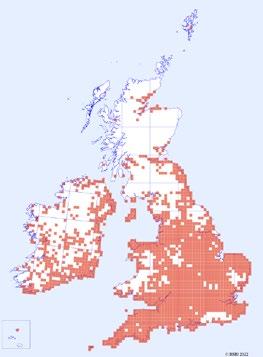
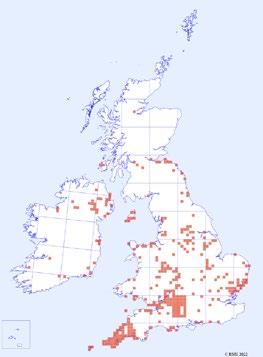
Figure 2. Distribution of C. ruber records over time. Each red square represents a hectad that contains monad specific data in the DDb.
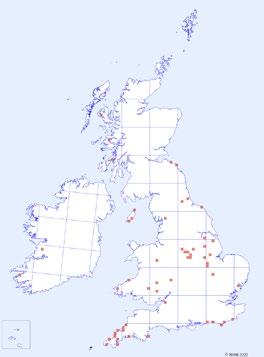
1990–1999 2000–2009 2010–2019
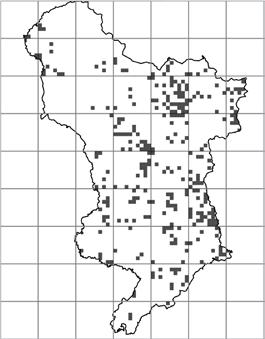
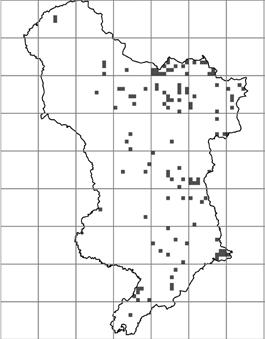
Figure 3. Distribution of monad specific C. ruber records by decade in v.c. 57. Each black square represents a monad.
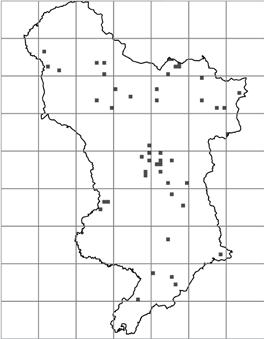
the Relative Apparent Change (RAC) was calculated by dividing the AC for C. ruber by the AAC for the two time periods being compared (Equation 3). RAC is thus a measure of fold change in the number of monads found to contain the chosen taxon when comparing the two time periods. i = time period
j = taxon n = number of taxa common to time periods (with monad specific data) Equation 1 – Apparent Change (AC)
Equation 2 – Average Apparent Change (AAC)
Equation 3 – Relative Apparent Change (RAC)
Table 2. Supporting data for, and the calculation of, C. ruber Relative Apparent Change in v.c. 57 comparing selected time periods. Time period Number of taxa (n) Distinct Monad Count (DMC) Apparent Change (AC) Average Apparent Change (AAC) Relative Apparent Change (RAC) (a) 1978–1999 1602 51 – – –2000–2021 1602 395 775% 290% 2.7
(b) 1990–1999 1326 50 – – –2000–2009 1326 123 246% 130% 1.9 2010–2019 1326 304 247% 182% 1.4
The results of these analyses are presented in Table 2. Comparing the time period of 2000–2021 with 1978–1999 (selected to represent more current versions of the 21-year periods used in The Flora of Derbyshire (Willmot & Moyes, 2015) produces a Relative Apparent Change value of 2.7 for C. ruber, i.e. the taxon is estimated to be present in 2.7 times more monads in the second time period versus the first (Table 2a). Performing change analysis by recent decades indicates Relative Apparent Change values of 1.9 for 2000–2009 vs 1990–1999 and 1.4 for 2010–2019 vs 2000–2009 (Table 2b). These analyses appear to confirm the casual perception that C. ruber has increased in v.c.57 in recent times.
Figure 3 is a geographical representation of the decades presented in Table 2b. In The Flora of Derbyshire (Willmot & Moyes, 2015), C. ruber is described as occurring ‘throughout the county, but more frequently recorded in the eastern half’. C. ruber would appear be heading towards a more uniform distribution in v.c.57.
Final thoughts
Whilst C. ruber is not currently classified as an invasive taxon in the British Isles, in South Africa it has been recognised as such for some time (Geerts et al., 2017). With seeds that are wind dispersed, deep roots and an ability to regrow after being cut back to ground level (personal observation), it is likely to invade more and more of the British Isles. Its spread could be related to global warming and a quick analysis (not shown) appears to indicate a trend to higher altitudes over time. However, the seeds can also be purchased from multiple sources, so gardening trends could also contribute to its spread. Whilst C. ruber does provide nectar for insects, it is possible that it could out-compete some native taxa in certain habitats and only time will tell.
Acknowledgements
I would like to thank Alan Willmot for his advice and comments during the preparation of this article. Thanks also to Angela Caunce for the photograph of C. ruber in SK08 and help with mathematical notation.
References
Geerts, et al. 2017. Emerging ornamental plant invaders in urban areas – Centranthus ruber in Cape Town, South
Africa as a case study. Invasive Plant Science and Management 10, Issue 4. Rose, F. & O’Reilly, C. 2006. The Wild Flower Key (updated 2nd edn). Penguin Books, London. Stace, C.A. 2019. New Flora of the British Isles (4th edn).
C & M Floristics, Middlewood Green, Suffolk. Walker, K. 2021. The BSBI and plant conservation – a response. BSBI News 149: 88–89. Willmot, A. & Moyes, N. 2015. The Flora of Derbyshire. Pisces
Publications.
David P. Blowers
New Mills, Derbyshire
davidp.blowers@gmail.com
Sarracenia purpurea (Pitcherplant) in Scotland
SARAH SMYTH
The stunning photo in the last issue of BSBI News (No. 149, January 2022) of the Sarracenia purpurea (Pitcherplant) on Rannoch Moor caused a great stir in invasive species circles and it stimulated a database check for locations in Scotland. Two current locations were thrown up – the Rannoch population and a new location. A bit of digging to verify the new location thankfully revealed that it was a transcription error somewhere along the way, which was easily sorted. That just left the Rannoch population which NatureScot has known about for many years.
NatureScot has a taken keen interest in Sarracenia purpurea in Scotland, since the Programme Board on Non-Native Species identified it in 2016 as a priority for eradication from the wild in Great Britain. It is a fairly recent arrival, first recorded as established in Scotland in 1991, and almost certainly planted
deliberately. It was recorded on Rannoch Moor in 1992 and has been regularly recorded ever since. A smaller population was recorded from Abernethy Forest, which consisted of around 15 plants. In 2006, RSPB took the management decision to remove it by hand, while this was still a viable option. A seed bank had not established, meaning this relatively simple intervention prevented the Sarracenia population from continuing at Abernethy, allowing the native species to thrive. The populations on Rannoch Moor were recorded from within a designated site, nationally important for amongst other features its beetle populations and wetland/aquatic habitats of international importance, including the blanket bog where the Sarracenia had established. Sarracenia purpurea is a fascinating plant; other deliberate introductions throughout the UK and Ireland were allowed to persist, offering a chance to observe and study. For example, ‘pitchers’ from Abernethy Forest contained several species of beetles, one of which was quite unusual. The individual plants can be long lived, though not all seem to be thriving as well as they do within their native range of North America. Discussions with NatureScot staff, landowners and partners suggested that although the population at Rannoch did not seem to be fluctuating very much, nor was there evidence of seeding, Dead colony of Sarracenia purpurea (Pitcherplant) in 2020 following herbicide treatment in 2019. A great illustration of how early our responsibility to protect Sites of Special Scientific Interest meant interventions can result in effective and cost efficient eradication. we should take action. The success is reliant on awareness and demonstrates why recorders Climate change also has submitting records are invaluable to conservation. A. MacMaster an influence. We can look to
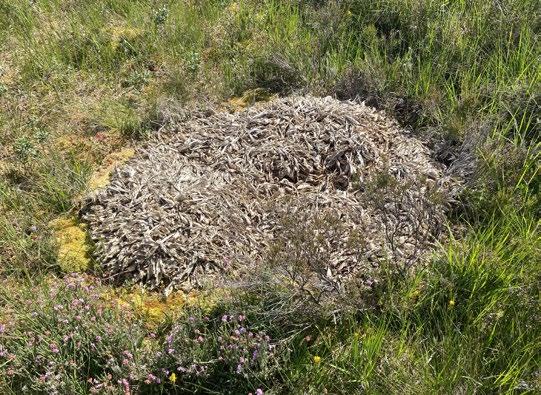
populations in southern Britain and Ireland where conditions are slightly milder (representing what the climate in Rannoch may be like in years to come) and in these areas there are ‘problem’ populations where repeated attempts at eradication have been challenging and expensive.
Sarracenia purpurea has been shown to thrive at the expense of the associated bryophyte communities; it can compete for the mossy cushion niches favoured by native Drosera spp. (Sundews) as well as actually shade out the bryophytes it is growing around. This could change the surrounding habitat. Rannoch Moor is internationally important as one of the most extensive and undisturbed blanket bog and fen complexes in Britain and the only place where the Rannoch-rush (Scheuchzeria palustris) is found.
In light of all these considerations control was decided as the best course of action; to treat the populations with a herbicide that was safe to use in wetlands. With landowner support this was done in 2019 and checking the site in 2020 and 2021 resulted in no sign of the Sarracenia. The photograph on the previous page shows a dead plant in 2021. As noted the seeds can remain viable for some time, so although seeds or seedlings were not noted from the population in Rannoch in recent years, another follow up check in 2022 is planned to confirm eradication.
Invasive non-native species cost Scotland more that £250 million a year in terms of control costs and economic damage, as well as causing significant harm to biodiversity and ecosystems. Yet to stop species establishing in the early stages can cost relatively little.
Two species that we would also like to hear about are Myriophyllum aquaticum (Parrot’s-feather): www. nonnativespecies.org/factsheet/factsheet.cfm?speciesId=2285 (see screengrab below) and Hydrocotyle ranunculoides (Floating Pennywort): www.nonnativespecies.org/ factsheet/factsheet.cfm?speciesId=1766. At present in Scotland Parrot’s-feather is only known from Glasgow and Floating Pennywort from Elgin. Aquatic species are often overlooked so any records of these would be of particular interest.
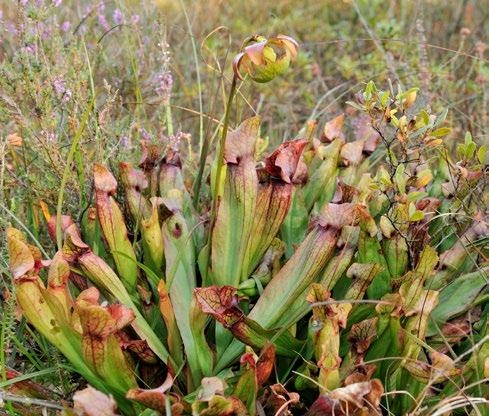
Sarracenia purpurea (Pitcherplant). Lorne Gill
Reference
Walker, K.J. 2014. Sarracenia purpurea subsp. purpurea (Sarraceniaceae) naturalised in Britain and Ireland: distribution, ecology, impacts and control, New Journal of Botany 4:(1): 33–41. DOI: doi.org/10.1179/20423497 14Y.0000000035
Sarah Smyth
Biodiversity and Geodiversity Adviser, NatureScot, Dingwall Business Park, Dingwall IV15 9XB
sarah.smyth@nature.scot
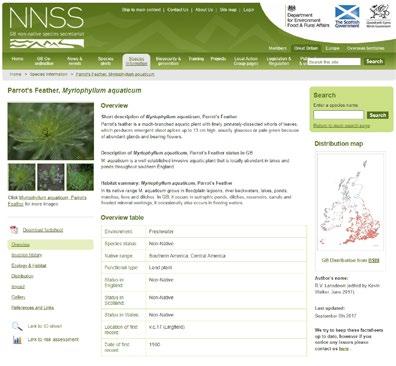
‘Tanks for the Memory’? Thalictrum simplex L. subsp. galioides (DC.) Korsh. – first record for Great Britain
DAVE GREEN
In September 1997 I was undertaking ecological survey work on the MoD at SPTA (Salisbury Plain Training Area) in v.c.8 (South Wiltshire). The site, although criss-crossed by a limited number of public footpaths is only open certain days of the year; otherwise, the area is completely out of bounds to the public to allow for army troop training and live firing; ‘The Plain’ as it is universally known, is off-limits.
However, a limited number of passes are issued for access annually and so it was with ‘Red Card’ approval in hand I was stood looking at a plant that I could not identify. As it was late in the botanical season, the colony that was around 5m², had finished flowering. I speculated that I was looking at either an umbellifer or a Thalictrum. I took specimens and using (as at that time) one of the new scanners on the market, scanned an image (Plate 1) and sent it to the late Mike Mullen, keeper at that time, of the herbarium at the Natural History Museum. He tentatively named the plant as Thalictrum simplex, but did not have any material in the Museum’s collection to compare it with. Mike suggested that I bring a specimen to the forthcoming BSBI Exhibition meeting that autumn. During that day, Francis Rose, passing me on his way to obtain a much-needed cup of tea, recognised it immediately. He confirmedthat it was T. simplex and then added, whilst continuing his approach to the tea urn, that there were several subspecies! I forwarded material to Eric Clement who determined that it was in fact Thalictrum simplex subsp. galioides. The colony of plants was revisited the following year with the relevant MoD conservation officers and notes on the habitat, together with a 6-figure grid reference were taken.
Eric, in a later note, asked me to publish the record; this article finally fulfils that request. At that time, I was also Vice-county Recorder for North
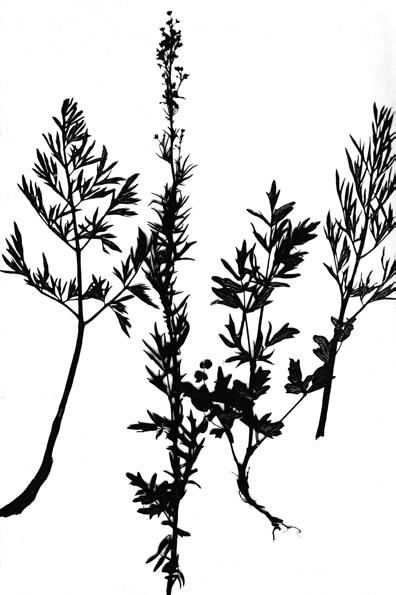
Plate 1. The original scan of the September 1997 Thalictrum simplex specimen. Dave Green
Wiltshire (v.c.7), but as this Thalictrum record was in South Wiltshire (v.c.8), I packaged up all the relevant information and sent it off to my opposite number, Ann Hutchinson, and in due course this record reached the local and national record centres. Alas, nothing else emerged from the record; the data I had sent was not returned and life and time went on.
Location
The site where I found the Thalictrum is contained within the Salisbury Plain SSSI which extends over 19,689ha, 12,933ha of which is unimproved
and forms the largest known expanse of chalk downland, not only in the UK but in Europe. The location of the colony lies within the Central Section of the SPTA, south-east of the village of Tilshead. This is part of the huge SSSI that consists of extensive, unfenced and unimproved chalk downland that has been under the MoD ownership, in some cases from the late 19th century. As mentioned earlier, much of this area has been used for infantry but also tank training since its purchase and churned up turves and tracks still seen today shows the ongoing use, with tree shelterbelts acting as hideaway areas for tanks on manoeuvres. This downland was, until the early 20th century, sheep grazed grassland for a considerable time prior to its compulsory purchase by the MoD. Salisbury Plain is now managed for its unique grassland and for those species that inhabit it. There had been little tree cover originally, but in the last 30 years or so the downland has been ‘augmented’ by the MoD by the planting of shelterbelts. The single Thalictrum colony was growing in species rich download turf in a matrix of NVC grassland types: CG3 Bromus erectus, CG2 Festuca ovina-Avenula pratensis and MG5 Cynosurus cristatus-Centaurea nigra grasslands. There were areas of recent disturbance with bare soil and turves thrown up in places.
Update of 1997 record to the present day
In 2014, I had the sad task of helping to sort through the botanical storage of the retired and recently deceased v.c.8 recorder, Ann Hutchinson. She had given over 30 years’ service and in that time had accrued much in the way of reference books and recording data. Whilst searching through one of the boxes I found the details of the Thalictrum I had sent to Ann all those years before. This re-ignited my interest.
In 2015, I applied and was issued with a new SPTA ‘Red Card’ pass that allowed me access to the site. Historical recall is a wonderful idea but on the ground it does not work that well! On my return to the area, I strode out confident that even without using the grid reference I would walk up to the location without a problem. Oh dear! I was so wrong. You will recall that I said that Salisbury Plain is huge and there I was standing in a very small part of it. That wonderful unimproved chalk grassland, looking identical to everything else I could see in all directions.
What were my clues in relocating the colony? There had been a piece of MoD rusting hardware in the immediate vicinity 18 years previously but clearly someone had moved it or blown it up as I couldn’t find it. I re-visited the Plain five times over the next four years, sometimes alone or with fellow botanists. It was not hard work hunting this plant on this wonderful sloping download as you never knew whether you were going to walk over clumps of Carex humilis (Dwarf Sedge), Orobanche elatior (Knapweed Broomrape), Linum bienne (Pale Flax), Genista tinctoria (Dyer’s-greenweed), Gentianella amarella (Autumn Gentian) or walk through drifts of Betonica officinalis (Betony), Fiilipendula vulgaris (Dropwort) or Succisa pratensis (Devil’s-bit Scabious). All rather distracting though.
The site had been revisited in 2002 by MoD conservation ecologists and an 8-figure grid reference had been taken. This second location was within several 100 metres of the first. Why was it so difficult to refind the location in 2015? Well, 1997 was prior to commercial GPS devices being available and you just calculated a six-figure grid reference the best as you could using a map and a couple of rulers. However, a 6-figure grid ref covers an area that is 100 × 100 metres and that is a big chunk of downland to search, especially if you are not convinced you are in the right place when you start and if you’ve got your grid reference right in the first place.
I never did refind it, nor the second site. Why not? Eventually by powers of deduction, I realised the first colony had been in the middle of a relatively newly created tank track. A track that has been used for many years and was now ground down to pure chalk. And there was no sign of the plant at the second locality, which is presumed lost.
Assessment
Was the Thalictrum simplex native, or was it an introduction, well naturalised and spreading? When found in 1997 it was growing up to 60cm in height and had flowered at mid-season, late June/July. It was rhizomatous and appeared to have perpetuated itself by this means. Due to the size of the clump, this colony had apparently been in this location for some years. There were no outlying specimens, with all plants appearing to be associated within the one colony, and no seedlings were observed.
Prior to finding the Thalictrum in 1997, the British Army had been returning all its hardware including its tanks from central Europe to Salisbury Plain, amongst other sites (the Berlin wall fell in 1989).
Thalictrum simplex subsp galioides is a native of mainland Europe, occurring on the central European plain, an area used by the British Army to train on. It can only be conjectured that the plant was brought back to this country as roots or seeds on the tracks of armoured vehicles and subsequently transferred itself to the SPTA.
Based on the European databases, Thalictrum simplex occurs from eastern France, through all of central and southern Europe, including Scandinavia, Asia to Mongolia and on through Siberia. T. simplex subsp. galioides has a much more limited distribution, but includes all of France, the Baltic states, parts of Scandinavia, Romania, Hungary, Ukraine and Yugoslavia. Based on these findings I believe my hypothesis still stands true for a Central European origin.
My supposition then is that it was an unintentional imported species or it was a completely unknown member of the native British flora, waiting to be discovered. You choose. In my mind, is the plant still there? Yes, somewhere, after all it is a big place. Oh well, ‘Tanks for the Memory’!
Acknowledgment
My thanks to Martin Buckland for commenting on this text.
Dave Green
36 Budbury Close, Bradford on Avon BA15 1QG
d.green7@btinternet.com
The status of Pancratium maritimum L. (Sea Daffodil) in Britain and Ireland
DAVID PEARMAN
Pancratium maritimum is a large bulb, almost confined to the Mediterranean, but also found up the western and northern coasts of Spain and Portugal, and then more scattered, up the western coast of France north to southern Brittany (Morbihan, islands of Houat and Hoedic).
The records from England and Wales are all recent – Slapton Sands (v.c.3) from 1994 (but see below); Marazion (v.c.1) from 2006; Dawlish Warren (v.c.3) from 2008; Merthyr Mawr, Bridgend (v.c.41) in 2018 and Sandbanks (v.c.9) in 2019. These five sites are summarised as follows:
Slapton, South Devon. The Flora of Devon (Smith et al., 2016) states that it has been noted there since 1994. But much better background has been received from the original finder, Ailsa Burns, who ran FSC courses at Slapton for many years. She writes (May 2019):
“I’m sure I knew the leaves, large and untidy and generally tarty when I was working at Slapton in 1960–62. But I had no idea what they were, until a passing tourist brought a flower in to the Field Centre, many years later. I don’t have that date. All this will seem very casual to you but I can only say that I have always regarded it as of garden origin
and it was outwith the Nature Reserve. The small clumps were/are in fact on the beach of fine shingle at Strete Gate at the northern end of the spit. I haven’t seen it since 2002 which was the last Wildflower Course I had at Slapton. The vegetation on the beach there is open but coarse and ‘weedy’, spectacular sheets of Echium, Centranthus, as well as nettle, docks, etc. There are some astonishingly nice houses with large gardens on the cliff top at Strete and I have always wondered if the plant came from one of those, presumably by a lucky seeding because the bulb is so huge it would be unlikely to have been a casual introduction. I cannot believe it was a natural occurrence.”
Marazion, West Cornwall. First found in 2006, just below the sandy path through the dunes, which led from the car park at Long Rock to the bridge at Marazion. In 2007 there were three clumps with five plants. At that time there was a chestnut paling fence below the site, at the top of the beach (which was washed away in later storms). I always thought it was very unlikely that the bulb could have been washed up from the sea, and found its way through the fence, up to a site about two metres above the level of the beach. I do not know when the fence was erected. It might have been a different matter with seeds. There have been persistent rumours of a nursery at Marazion that specialised in succulents and bulbs, from which this might have arrived. The owner has recently died, and nothing further has been traced.
Dawlish, South Devon. The recent Flora of Devon (Smith et al., 2016) notes that it was ‘found with other garden species on the site of an old chalet garden at Dawlish Warren NNR’. However, there is another story which indicated that it was not on the site of a hut!
Sandbanks, Dorset. One plant on dunes. See BSBI News 143 (January 2020), p.45. In 2020 there were four plants, in 2021 three. It was near gardens, in a site above the line of mean high water spring tides (as in Marazion and Slapton).
Merthyr Mawr Burrows near Bridgend, Glamorgan. Discovered in 2018. In the area there have been years of concerted effort to remove most of the Sea-buckthorn (Hippophae rhamnoides) on the dunes here and indeed near the site of the Pancratium.
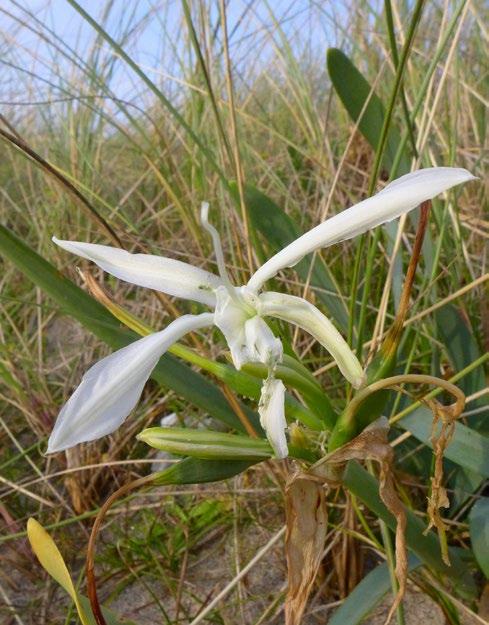
Pancratium maritimum (Sea Daffodil), Marazion, Cornwall (v.c. 1). Fred Rumsey
There are a few non-native trees around. Frankenia laevis (Sea-heath)(assumed to be introduced as a very long way from native sites which are deemed to be native) turned up on the saltmarsh nearby in 1980 and has spread quite widely here. There is also a colony of Asarum europaeum (Asarabacca) in the dunes that is quite large but may be expanding slowly and probably has been for years or decades (first seen in 1936). Other more recent arrivals include Erigeron floribundus (Bilbao Fleabane) and Cotula coronopifolia (Buttonweed).
Habitats
A French correspondent writes (2007) that ‘it grows there on the white dune (mobile/fore dune) or on the edge of the grey (stabilised); the back of mobile dunes with Elymus sp.; stable dunes with Helichrysum stoechas, Koeleria macrantha; decalcified dunes with
lichens and Corynephorus canescens; and even in the bracken, and also in enriched areas with nitrophilous plants (Beta, Raphanus, Matricaria)’.
The Marazion site is a very open, almost a pure Ammophila (Marram) dominated site, with Elymus (Couch grasses), and small areas of Carex arenaria (Sand Sedge) and Euphorbia paralias (Sea Spurge). The associates at Slapton and Dawlish are of ruderal plants.
Discussion
The Red List Group is the body charged by JNCC to maintain the list of IUCN Threat statuses of all native plants in Great Britain (for background see Pearman & Leach, 2017). We use the following ten criteria from Pearman (2007), adapted from Webb (1985), when assessing claims of status: • First date in cultivation – Pancratium maritimum has been grown in British gardens for over 400 years. John Gerard grew in his garden by 1596. There were only five suppliers in the RHS Plantfinder 2019. • First date in the wild – 1990s, possibly 1960s.
•Presence in semi-natural habitats and
in plant communities – It occurs in seminatural habitat.
•Spatial coherence in Britain and Ireland
– None. • Trends in frequency (dynamism) – Too few to assess. • Persistence – It has persisted for almost 30 years, or more, at Slapton and at least 15 in
Marazion. • • Use – A garden plant, albeit uncommon. European range – Pancratium is perceived as native up to the coast of southern Brittany, albeit rare in the north of its range. • • Archaeological evidence – None. Genetics – None to our knowledge, but any work might be of interest.
The Red List Group considered the available evidence, which really came down to whether it arrived by natural means, on ocean currents, or was planted. Whilst the former was possible, it was thought that the rarity of the North-west France populations and the considerable distance from the more widespread populations in Spain and Portugal made this unlikely, though the seeds at least must have buoyancy. All the evidence points to a very recent arrival. The Narcissus-like leaves are persistent throughout the year, are very obvious on the strandlines, and are unlikely to have been overlooked by botanists in the past. We do not know enough about warming seas and milder winters in England and Wales to be able to say whether these might make natural colonisation more likely. All the current sites are near or fairly near to habitation.
The Red List Group regularly reviews species on the Waiting List, which is viewed as a short-term treatment, so as to encourage further research. At their meeting in November 2021 the Group decided that there seemed very little likelihood of further evidence emerging for the foreseeable future, that all the current evidence pointed to introductions, and decided to move this species from the Waiting List this onto the Parking List. We do acknowledge that a changing climate is leading to arrivals, especially of orchids, and it is difficult to separate natural arrivals from introductions.
References
Pearman, D.A. 2007. “Far from any house” – assessing the status of doubtfully native species in the flora of the British
Isles. Watsonia 26: 271–290. Pearman, D & Leach, S. 2017. The Red List group and their work. BSBI News 134: 62–63. Smith, R, Hodgson, R. & Ison, J. 2016. A New Flora of Devon.
Devonshire Association, Exeter. Webb, D.A. 1985. What are the criteria for presuming native status? Watsonia 15: 231–236.
Acknowledgements
Members of the RL group, particularly Fred Rumsey, Pete Stroh and Julian Woodman, together with Roger Smith, Ian Bennallick and David Leadbetter.
David Pearman
Algiers, Feock, Truro TR3 6RA
dpearman4@gmail.com
Plant introductions with coco peat
ALAN C. LESLIE
Coir is a coarse, very durable fibre, which is slow to degrade even in water, and is derived from the husk of coconuts (Cocos nucifera). The traditional production process to extract the fibres involves sundrying of the husks followed by a long period of immersion in water to swell and soften the fibres (a process known as ‘retting’), followed by the physical extraction of the fibres. The residual pith remaining after most of the fibre has been extracted, is milled, compacted and marketed as ‘coco peat’. It is this that has become popular as a substitute for moss peat in commercial potting composts and is the source of a range of introduced plants whose seeds have inadvertently become incorporated within the coco peat. Coir fibre can also be imported as the coarse fibre, or in chip form, as well as already made into a variety of products such as doormats and planting pots, and is also used in hydroponic cultivation. It is also now quite widely seen in the wider countryside, used as mats or rolls implanted with native plants and laid on banks or margins of aquatic habitats to assist in revegetation and the stabilisation of banks and slopes. A significant proportion of the supply originates in India or Sri Lanka, where its production is an important industry and where it is used to make a wide variety of other products such as ropes, mattresses, floor tiles, brushes, sacking and fishing nets.
One of the most detailed studies of the accidental introduction of plants with coco peat was described by James et al. (2012) from New Zealand, following the discovery by an observant nurseryman of ‘some strange looking plants’ growing from his potting mix. Further investigations revealed similar plants in other nurseries and these were traced to the coco peat used in the potting mixes, imported in this instance from Sri Lanka. The Ruakura Research Centre in New Zealand grew on all these plants to establish their identities and also laid out the soil to see what more might emerge from the compost. They finally listed 44 species derived from this source, many of which were new to the country, and instituted remedial measures to reduce the instance of further introductions. Relatively few observations seem to have been made in this country or in Europe, although Cleome gynandra was reported by JuradoMcallister et al. (2020) as introduced in this way in southern Spain, as were Dactyloctenium aegyptium and Glinus oppositifolius in the Balearic Islands, as noted by Cerrato et al. (2021). Clement & Foster (1994) mention coir as a source of alien plants in the British Isles and specifically note this as a potential source under the entries for Amaranthus blitum, A. spinosus and Ricinus communis.
The introductions reported below have all occurred on Monksilver Nursery, at Cottenham, Cambridgeshire (v.c.29, TL4366) between 2018 and 2021, the majority called to my attention by the proprietor Joe Sharman, although I have been responsible for their determination. The commercial nursery compost has incorporated a coir element for some years and although this material is supposed to arrive in a sterilised condition, there have been reports of a live scorpion being found in it on one occasion! The following species, which have occurred on the nursery as pot weeds, are believed to derive from this source:
Amaranthus viridis (Amaranthaceae). Known as Green Amaranth, this South American annual is widely naturalised throughout the tropics and is cultivated as a vegetable in India. It has long, narrow, terminal inflorescences, slightly emarginate leaves and muricate fruits. One plant in 2021.
Bidens ferulifolia (Asteraceae). Known as Apache or Fern-leaf Beggarticks, this yellowflowered perennial, with finely divided foliage, has become a popular garden plant in this country in recent years, where it is frequently grown as an
annual. It has not been grown previously on the nursery. It is also known as a garden ornamental and escape in India. One plant in 2021.
Cleome viscosa (Cleomaceae). Known under various names such as Dog Mustard or Yellow Spider-flower, this yellow-flowered, glandular annual is probably of tropical African origin but is widely naturalised across the tropics. It is sometimes treated as Arevela viscosa. At least six plants occurred in 2021, but some very tiny plants seen the previous year, which defied identification at the time, may have been this. In Sri Lanka the seeds are sometimes used as a cumin substitute.
Malvastrum coromandelianum (Malvaceae). Known variously as Broom Weed or Prickly Malvastrum (there are spines on the fruits), this is considered native in tropical America, but is naturalised throughout the tropics. It is an annual or short-lived perennial with small, yellow or orange-yellow mallow-like flowers and has reputed medicinal properties. One plant in 2018.
Mollugo nudicaulis (Molluginaceae). Known as Naked Stem Carpetweed, this annual is another pantropical weed, thought to be native of parts of Africa and Asia. It also has established medicinal uses. It makes a loose basal rosette of narrowly obovate leaves, from which springs a leafless stem
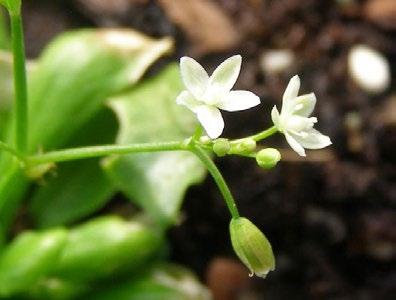
Mollugo nudicaulis, Monksilver Nursery, Cottenham, Cambridgeshire (v.c. 29). Joe Sharman with a much-branched cymose inflorescence with tiny white flowers. One plant in 2021.
Phyla nodiflora (Verbenaceae). This rejoices in, amongst others, the soubriquets Sawtooth Frogfruit or Turkey Tangle Frogfruit and is widely distributed in the warmer regions of the world. It was at one time treated as Lippia nodiflora. In habit it is a low perennial carpeter, with serrate leaves and white flowers in a small tight head. In some areas it is grown as a ground cover, but is considered invasive in others, and has, very rarely, been recorded as a garden weed in the British Isles. One plant in 2021.
Phyllanthus maderaspatensis (Phyllanthaceae). The Madras Leaf Flower is considered native across parts of Africa and Asia, south to Australia, but is otherwise a widespread weed in warmer parts of the world. It is another with known medicinal uses. It is perennial, but can flower in its first year from seed (as it did here) and resembles an odd-looking, erect version of one of the little prostrate alien spurges, such as Euphorbia prostrata. One plant in 2021.
The records for Phyllanthus maderaspatensis, Cleome viscosa and Mollugo nudicaulis may be the first British records for these species. Specimens of all the records mentioned above will be placed in CGE in due course.
The New Zealand list included both M. nudicaulis and C. viscosa, as well as other species of Amaranthus and Phyllanthus. It is notable that it also recorded 14 species belonging to either the Cyperaceae or the Poaceae and so far none of these have been seen here, but it is more than likely that they may have been weeded out before they could be recognised as of interest, a situation which leaves those weeding in the nursery with quite a dilemma in future! It is unlikely that this crop of new British aliens is unique and that other nurseries and gardens will have these or other species to add to the list. Recorders should keep an eagle eye out in the latter part of the year, the period when most of these have come to light on the nursery.
References
Cerrato, M.D., Ribas-Sera, A., Cardona, C. & Gil, L. 2021.
Species introductions through coconut fibre: Dactyloctenium aegyptium and Glinus oppositifolius, new records for the
Balearic Islands, Spain. Acta Botanica Croatica 80(2): 221–224. Clement, E.J. & Foster, M.C. 1994. Alien Plants of the British
Isles. Botanical Society of the British Isles, London. James, T.K., Champion, P.D., Bullians, M. & Rahman, A. 2012. Weed biosecurity breach through coco peat imports. Pakistan Journal of Weed Science Research 18: 249–256, Special
Issue. Jurado-Mcallister, A., Blanquer, I., Romero-Rubira, C.,
Laguna Lumbreras, E. & Ferrer-Gallego, P.P. 2020. Cleome gynandra L. (Cleomaceae), nueva especie aloctona en la flora continental Europea. Flora Montiberica 77: 86–90.
Alan C. Leslie
109 York Street, Cambridge CB1 2PZ
alanleslie53@gmail.com
An overlooked form of Digitaria sanguinalis (L.) Scop.?
MATTHEW BERRY
In October 2020, after having been in Eastbourne to do some survey work, John Norton informed me of a population of a probable Digitaria species he had seen in the area of sandy ground that lies close to Martello Tower no. 66 on the west side of the harbour mouth, a little way east of Langney Point (TQ64300123). John was busy meeting a client and had not been able to have a closer look, so I made my way to the location as soon as I could. The plants keyed out as D. sanguinalis (Hairy Finger-grass) but the spikelets had a very ‘whiskered’ appearance which I could not remember ever having seen in other populations of this species. The plants actually looked a very good fit for D. sanguinalis subsp. pectiniformis Henrard. According to the couplet in Manual of the Alien Plants of Belgium (alienplantsbelgium. myspecies.info/content/digitaria-sanguinalis), it differs from subsp. sanguinalis in having ‘long, glassy, more or less divergent bristles emerging from crateriform protrusions’ on margins of the mature lower lemmas. The spikelets of the most extreme examples in the Eastbourne population were a good match for the drawings depicting subsp. pectiniformis on the website. There is also a link there to a 2010 paper in a Czech journal detailing the distribution of this infraspecific taxon on the railways of northern Moravia and Silesia. It contains a good black and white photo showing the characteristic ‘whiskered’ spikelets of subsp. pectiniformis.
There are no records in the DDb but it seems quite unlikely that this is truly the first and/or only site in Britain, thus my quizzical title for this short note. I’d be interested to hear about any other records. The small Eastbourne population was still observable in 2021.
Matthew Berry
Flat 2, Lascelles Mansions, 8–10 Lascelles Terrace, Eastbourne BN21 4BJ
m.berry15100@btinternet.com
Plant Alert – March 2022 update
APRIL WEBB
Spring has sprung on another year of Plant Alert! Now in our third year and with the growing season in full swing, it is time to get out in the garden or allotment and spread the word to horticultural friends, neighbours and colleagues to do their part. For members who may not be familiar with Plant Alert, we are a long-term citizen science partnership between the BSBI and Coventry University aiming to identify the potential invasive ornamental plants of the future.
While maintaining the benefits and contributions of non-native plants to our gardens, we need to know at an early stage which of those plants might go on to endanger habitats outside gardens. There is an approximate 125-year time lag between a new plant being introduced in horticulture and it first being found outside of gardens. By inviting gardeners to report troublesome ornamentals in their gardens, Plant Alert aims to understand the behaviours of the ornamentals we are buying and planting before they have had a chance to escape and become a problem. As botanists, we often encounter escapees and unfortunately come across some with severe long term environmental and economic impacts.
Data collected from Plant Alert is used in risk assessments of species and to provide gardeners and nurseries with advice on which plants could also become difficult to manage in gardens. We invite all gardeners to use the Plant Alert website and report ornamentals that are spreading to an extent that you have to control them to prevent them overgrowing other plants or to parts of your garden where you do not want them. We ask for these traits as they are general indications of strong growth. To take part visit www.plantalert.org.
2021 Achievements
The year 2022 has a lot to live up to, with last year being a proactive year for gardener and scientist engagement. The project featured in New Scientist, BBC Wildlife magazine, and presented webinars for the Non-Native Species Secretariat and a live educational session by the Field Studies Council BioLinks Live, covering gardening with noninvasive ornamentals. The Plant Alert team has also been involved in supporting the Non-native Species Secretariat with their revision of a brochure ‘gardening without invasive plants’ using Plant Alert records.
For those wanting to learn more the presentations can be found at the links below.
April Webb
support@plantalert.org
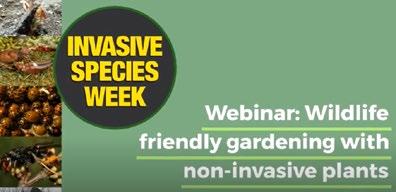
Presentation from May 2021 for Non Native Species Secretariat – Invasive Species Week ‘Gardening for wildlife with Non-invasive Ornamentals’: youtu.be/ pwLKa2lH_74.
Field Studies Council BioLinks Live ‘Finding the Invasive Plants of the Future’: youtu.be/ jn4pZyCTMls.
